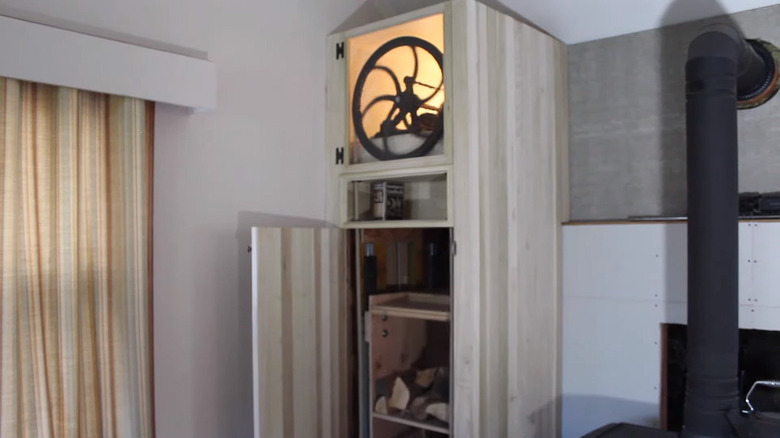Tired Of Lifting Firewood To Your Wood Stove? This TikTok DIY Will Save Your Back
It's cold. There's a 1 in 3 chance you're supposed to be sleeping. Your back is sore from the last time. You know you should never store your firewood indoors, but this is getting old. And if you find one more bug in your hair from toting that firewood up the long flight of deck steps... but wait. The father of TikTok DIYer Sheli (@houseonwilshire) devised a way to get that firewood to the right floor, and it's the same way lots of people get to the right floor every day: an elevator.
This isn't an entirely new idea. Dumbwaiters have moved goods and materials vertically for at least 2,200 years, and a number of companies make them for residential and commercial use. These mini elevators might strike us now as bizarre features of old homes that need an explanation in a post-servant world, but the firewood lift makes perfect sense. At least one company, WB Fowler Industries, makes firewood lifts, and there are more than a few DIY examples online. But few boast the polish and engineering prowess of @houseonwilshire's dad.
The basics of DIYing a firewood lift
A firewood elevator isn't going to be the most complicated thing in your home, and it might not be the most complex thing you DIY. But there are a few requirements you might not think of at first. You need a carriage for the firewood... and an elevator car, as it were. @houseonwilshire's resembles the cars used by Fowler's WoodWaiter, but you could use any firewood rack (like this steel log bin from Lowes, $80.12) that's sturdy enough to stand up to the job and is strong enough in all the right directions. You also want your car to move up and down, of course, and for that, you'll need something like a winch. ASME standards (more on these later) require that dumbwaiters have a 500-pound minimum capacity, and even the cheapest Harbor Freight utility trailer winch ($59.99) has a 2,000-pound capacity. In the simplest arrangement, you'll need a controller at the top of the elevator, but it would be ideal to have one at the bottom as well for when you forget to send the lift down.
A firewood elevator dangling by a cable presents all manner of safety and functionality issues, and one way to quickly eliminate most of them is to somehow constrain the car from moving horizontally while allowing it to move vertically. @houseonwilshire's father accomplished this using unistrut channel ($35.48 for 10 feet at Lowe's, but available at any big-box hardware store) and probably something like strut bearing trolleys ($14.65 each at Lowe's).
Some things to consider before building
You're also going to want your car to automatically stop in just the right place. Limit switches are often used for this. Another common mechanism for stopping a dumbwaiter or firewood lift is slack-wire switches, which detect when a cable goes from taut to slack. This is useful at the bottom (but not the top) of the carriage's run, and also as a safety mechanism, which brings us to some things to consider before building your firewood elevator. The ASME building standards for devices like dumbwaiters are widely adopted in local building codes to ensure their safe operation. These rules contain a lot of wisdom, so let's look at a few of them. Perhaps most importantly, it's smart to build your entire lift outdoors. Because fire loves a vertical channel to travel in and must be prevented by airtight fire blocking, constructing indoor lifts and dumbwaiters can be too demanding for a DIY project.
It's also a good idea to lock any hoistway doors and, if the controls aren't protected by those locks, to lock them as well or use a key-operated switch. This is especially important where children are present. Make sure everything is sturdy enough to do its job for the foreseeable future by using wire cable rather than rope, using graded fasteners, etc. There are many more regulations that might be required by your local governing authority, so for more details check with the permitting office when you start the project.

